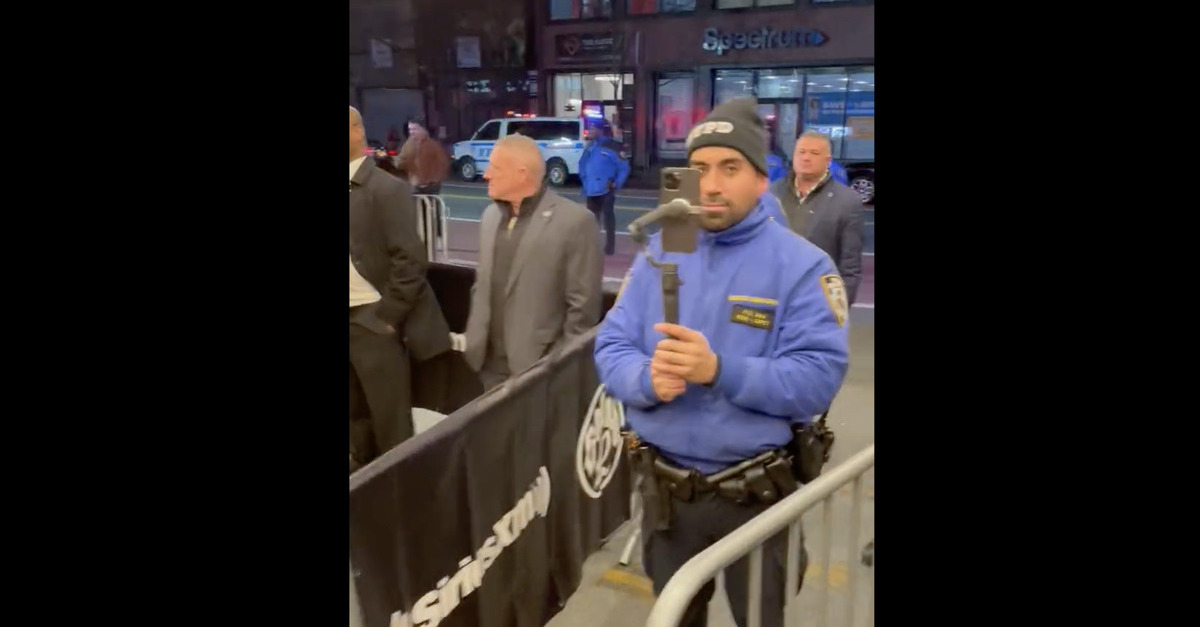
An NYPD officer captured video footage of Drake fans leaving a concert at the Apollo Theater.
Drake fans leaving a concert Saturday night at the Apollo Theater in Manhattan found themselves the subject of some now-controversial video footage, courtesy of the NYPD.
As audience members exited the theater, they passed by an officer filming them.
Some brief footage of the officer doing the filming can be seen below.
Now, privacy advocates have decried the NYPD’s right to film people without their consent— as well as concerns over the ultimate use of that footage.
The NYPD identified the cameraman as a community affairs officer from the 28th Precinct’s social media team and said the footage is intended for use on the precinct’s social media accounts to highlight community events. The NYPD also said that the footage would not be used for any other purpose.
Although a civil rights advocacy group expressed concern over the recording, the police clearly had the right to film the passersby. Members of the NYPD have the same right as all other individuals to videotape individuals leaving concerts for the same reason people can legally videotape police conducting law enforcement business: there is simply no expectation of privacy on public streets.
Under federal and state law, individuals only have a qualified right to privacy in places in which there is a “reasonable expectation of privacy.” A public sidewalk outside a concert venue, however, is not such a space; rather, a public exit from a crowded performance onto a public street is perhaps the antithesis of an objectively private location.
Certainly, the Drake concertgoers would be entitled to legal protection from misuse of footage (such as unauthorized commercial usage or certain public broadcasting) but would have no legal basis for preventing police from capturing the video, even without their consent.
The fact that police may legally capture or keep footage does not, however, speak to the use or admissibility of that recording at a later time.
Some have voiced concerns that the NYPD might use the recording for other investigative means.
Journalist Nida Khan commented on Twitter that the recording was “Sadly, not surprising,” and likened it to the secret intelligence unit termed the “‘hip-hop task force‘” once rumored to exist within the NYPD.
Questions have been asked whether the video could be used in conjunction with facial recognition software as part of a criminal investigation. Like many law enforcement agencies, the NYPD uses facial recognition technology as a tool to identify criminal suspects. The department says that the technology is used only in conjunction with human analysis and that no one has ever been arrested solely based on a facial recognition search.
Therefore, if the officer’s video captured evidence of a crime after the Drake concert, that footage might be used together with facial recognition technology and other tools to identify the perpetrator.
Law&Crime spoke with personal privacy law expert Bryan Sullivan, founding partner of Early Sullivan Wright Gizer & McRae, on Tuesday, who explained that while the NYPD clearly had the legal right to take video outside the Apollo because there was no expectation of privacy on a public street, it likely would only use the footage as part of an investigation for a serious crime if one was committed at the event.
“For example, if a violent crime such as a shooting or terrorist attack were to take place in or near the theater, the exit video might be helpful to identify witnesses or track down the perpetrator,” said Sullivan. “However, it is highly unlikely that the police would employ such a technique for minor offenses.”
Sullivan also pointed out that in the event a serious crime occurred, law enforcement would likely look not only to its own video captured for social media, but also to surveillance video inside the theater, personal videos taken by audience members, and professional recordings made by the performers.
https://www.instagram.com/reel/CnvRPw8hx3X/?utm_source=ig_embed&utm_campaign=loading
Given that the NYPD’s video was legally obtained, there would be no legal basis for prohibiting its usage in any such context.
If the police did use the video as part of a criminal investigation, it would probably do so in conjunction with facial recognition technology. On its website, the NYPD specifically says that “a facial recognition match does not establish probable cause to arrest or obtain a search warrant, but serves as a lead for additional investigative steps.” Facial recognition is still a developing technology, and its use in criminal investigations has been widely criticized for its lack of reliability.
Even if the video were key to tracking down a criminal suspect, the video might not be admissible in court as part of any civil or criminal case. There are extensive evidentiary rules regarding the admissibility of video footage in New York state court, and a presiding judge would have full discretion as to whether to allow its use.
In addition to being relevant to the case, the video would also need to be “authenticated” — meaning that a witness would be required to testify that the video was an accurate representation of what it depicts. Therefore, any courtroom use of the post-concert tape would likely require the participation of the officer who conducted the filming.
Sullivan said that while the police would have the right to make the video or use it in an investigation, in some contexts, police video recording could amount to interference with free assembly.
“If police were known to videotape people entering or exiting an event of a political or controversial nature, it might deter individuals from attending — and thereby constitute a violation of free assembly rights,” said Sullivan. He added that attendance at a Drake concert is unlikely to be the kind of activity that police video recording would be a deterrent for those who attend.
[screengrab via Twitter]